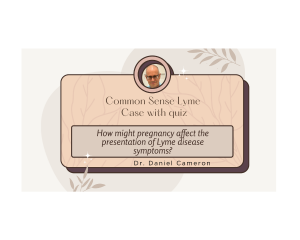Call for your appointment today 914-666-4665 | Mt. Kisco, New York

Doctors described a 67-year-old avid outdoorsman who received treatment for Lyme arthritis after having had knee surgery. Ten months earlier, the man had received a partial knee replacement for his left knee due to advanced single compartment degenerative arthritis.
Over a 3-month-period, the man developed progressive left knee pain and swelling. He later presented with a moderate joint effusion but did not have an erythema migrans rash, warmth, instability, or significant pain with range of motion.
There was no history of a tick bite or trauma to the knee nor was there evidence of joint effusion, infection, or Baker’s cyst.
Aspiration of his knee revealed turbid purulent pleocytosis with 91.8% neutrophils, elevated C-reactive protein, and a positive Borrelia burgdorferi polymerase chain reaction (PCR).
Serologic tests were positive for an elevated erythrocyte sedimentation rate (ESR), C-reactive 0.7, and a positive B. burgdorferi antibody enzyme immunoassay (EIA) test and 10 of 10 immunoglobulin G (IgG) Western blot bands were reactive.
Lyme arthritis diagnosis
Based on the detection of B. burgdorferi sensu stricto DNA by PCR, clinicians diagnosed the man Lyme arthritis, a particular type of periprosthetic joint infection (PJI).
The diagnosis was based on criteria established by the Musculoskeletal Infection Society and the Infectious Disease Society of America (IDSA).
“Although there was no communicating sinus tract or direct result from traditional microbiological culture, our patient met these criterion for PJI based upon elevated synovial fluid leukocyte count (>3000 cell/µL), elevated synovial neutrophil count (>65%), purulence, and evidence of a microorganism with identification to the level of genus and species,” according to Wright and colleagues from the Division of Infectious Disease, Department of Medicine, Memorial Medical Center in York, Pennsylvania.
The authors summarized their concern over the seriousness of a PJI. “Periprosthetic joint infection is a devastating complication following joint arthroplasty that causes significant morbidity with an estimated cumulative incidence of 1% – 2% for both hips and knees,” the authors write.
IDSA treatment guidelines not applicable
Wright and colleagues concluded that the IDSA recommendations were not applicable to this patient. They cited two guidelines that would have limited the types of treatment to oral antibiotics and duration to no more than four weeks. These included:
- “Late Lyme arthritis can usually be treated successfully with antimicrobial agents administered orally (e.g., doxycycline, amoxicillin, or cefuroxime) for 28 days in adult patients without evidence of neurologic disease.”
- “Previous studies have also been published demonstrating the efficacy of once-daily ceftriaxone (2 gram dose) for 14 or 28 days in the treatment of late Lyme disease.”
Successful treatment with antibiotics
The 67-year-old man received treatment for Lyme arthritis which included antibiotics rather than undergoing surgical incision and drainage or excision arthroplasty. Twice daily, 100 mg of oral doxycycline was initiated empirically for a week until testing confirmed the diagnosis. The treatment was converted to a six-week course of daily intravenous 2 grams of ceftriaxone.
The antibiotic treatment for Lyme arthritis was successful. “Clinically, the patient had cessation of his knee pain, resolution of joint effusion, normalization of synovial infection and inflammatory parameters, and negative end-of-therapy detection of B. burgdorferi DNA by PCR,” according to Wright.
However, the authors cautioned that their strategy of prolonged intravenous antibiotics might not be effective in other types of joint arthroplasties.
“Although this patient’s clinical outcome was achieved without the need for surgical incision and drainage or staged excision arthroplasty procedure, it is unclear whether this same strategy would produce similar results in patients with other types of joint arthroplasties,”
Are there any other cases of arthroplasties that might be prevented by antibiotic therapy? More than 82,660 patients underwent total knee arthroplasty (TKA) across the Medicare and United Health Care populations from 2009 to 2011 at a cost exceeding $10 billion per year. [2]
Authors’ Conclusion
“This case highlights how early prompt diagnosis and adequate antimicrobial therapy may obviate the need for additional aggressive orthopedic surgical intervention,” stressed Wright.
“This case also highlights the value of an aggressive need to further investigate and interpret unexpected findings in clinical practice.”
Related Articles:
5 cases of Lyme arthritis following an operation
Will steroid injections help children with Lyme arthritis of the knee?
Preventing unnecessary surgery for children with Lyme arthritis
References:
- Wright WF, Oliverio JA. First Case of Lyme Arthritis Involving a Prosthetic Knee Joint. Open Forum Infect Dis, 3(2), ofw096 (2016).
- Cohen JR, Bradley AT, Lieberman JR. Preoperative Interventions and Charges Before Total Knee Arthroplasty. J Arthroplasty, (2016).
- Fallon BA, Keilp JG, Corbera KM et al. A randomized, placebo-controlled trial of repeated IV antibiotic therapy for Lyme encephalopathy. Neurology, 70(13), 992-1003 (2008).
- Cameron DJ. Consequences of treatment delay in Lyme disease. J Eval Clin Pract, 13(3), 470-472 (2007)




My son has chronic lyme disease. He has it in his left knee. We have tried antibiotics, biofilm busters, oxidative therapies Iv antibiotics( only once)
Any suggestions we live in Maine
Call the office at 914 666 4665 if you need any information
Dr Cameron, I contracted Lyme Disease in 1989 and have been treated and manage my Chronic Lyme Disease. I had a knee replacement 4 years ago and I need another as soon as I can solve this problem. In January my knee replacement knee became inflamed and after careful evaluation for loose parts and bakers cyst, no reason could be found. I am anxious about getting another knee replacement and have the same problem, so I am trying to find out more. My primary care is Dr. Daniel Peterson of Incline Village Nevada, I am also part of studies at Columbia with Dr. Brian Falon. I would like to arrange to have the fluid remove from the knee replacement to see if the bacteria could be cultured. Where could I send the sample. I live in Santa Rosa, California. I would be able to travel to get this done. Thank you, Barbara McKenna, age 69. sten47@gmail.com
Barbara S. McKenna, sten47@gmail.com
New York has supported cultures. We are not clear on where to sent the fluid.
I acquired a patient who had total knee arthroplasty after delayed treatment for EM rash just 2 months earlier. previous to this he had Lyme diagnosed in past with IDSA treatment. I believe at time of surgery for knee he was not treated adequately for his very recent and remote infections, then underwent the surgery. I met him a year later when informed he had to retire early due to persistent pain in the knee and has declined since, with multi system symptoms. Tried oral combinations then Bicillin with no benefit. Not clear if persistent infection, biofilm, immune activation. Is there value in IV Ceftriaxone at this point? surgery was 2017, met him 2019
Hello,
My name is JoAnne Hopkins. I am a 61 year old female status post bilateral total knee replacements in Jan 2016. Initially the result was very good and the pain was alleviated. However, I was diagnosed about a year later with Lyme disease when I had a spontaneous rupture of my extensor pollicis longus tendon of my left thumb. I never had a rash so my lyme went untreated for quite sometime. I see a lyme specialist regularly since then and have been on and off oral antibiotics for 4 1/2 years. After being off the antibiotics for approximately 6 months (this was about 2 years ago) I developed increased pain in both of my knees. I have since been back on oral antibiotics but feel the damage has been done and the knee pain is getting worse. The orthopedist has taken X rays at least 2 or 3 times since then and he states that there is no orthopedic reason for my increased pain. He states that he could aspirate but as there is no real edema present, he didn’t think it was a good idea due to risk of infection. My Lyme specialist is also not familiar with this. I have asked numerous doctors about the lyme being the cause of this increased pain but none seem to have any experience with it. I recently had lumbar surgery, 4 months ago, for chronic pain due to spondylolysthesis, and am starting to have increased pain again. I an fearing that the Lyme has now invaded that region as well. When I saw this article about the lyme infection post knee surgery I was very excited. I am hoping you may have some suggestions that I could relay to my lyme specialist. Some questions I have are should I proceed with the aspiration? Should I see an infectious disease specialist? I don’t live very far from New York as I reside in west central New Jersey. Thank you for your time. I look forward to hearing from you.
I have patients who have a history of orthopedic surgery or an orthopedic injury who have benefits from antibiotics. It is hard to judge whether additional antibiotics would be helpful.
Dr. Cameron
First thank you for all the information you put out for us with Lymes and co-infections (babesia).
I had arthritis in my feet, surgery was done several screw put in. In the same timeframe surgery on my wrists and elbows.
Two years later the pain in my feet continued to get worse we could see the rejection of hardware and the hardware was removed All but on screw right big toe.
June I had L-4 L-5 laminectomy and fusion. 4 screws, disk and bone graph from hip.
I have continually worried about another rejection, the pain has been extreme in left buttock to toes since the surgery.
Anxiety has been high since surgery
I have written all this and can’t remember my original thought. This happens often. Any thoughts from you on this
Same here, knee replacement 8/19, no problems, tick bite, 4/21, 4 weeks doxycycline, therapy, 2 aspirations now, clear fluids . Thought replacement would help me enjoy grandchildren, but instead dealing with pain, swelling, can’t do flowerbeds, limited activities with children, at 71 I’m not to old to enjoy retirement, instead dealing with pain, swelling, limit Ed activities, depressing…both drs don’t seem to have all the facts on this!
Same here, knee replacement 8/19, no problems, tick bite, 4/21, 4 weeks doxycycline, therapy, 2 aspirations now, clear fluids . Thought replacement would help me enjoy grandchildren, but instead dealing with pain, swelling, can’t do flowerbeds, limited activities with children, at 71 I’m not to old to enjoy retirement, instead dealing with pain, swelling, limit Ed activities, depressing…both drs don’t seem to have all the facts on this!